Connector容器主要负责解析socket请求,在tomcat中的源码位于org.apache.catalina.connector和org.apache.coyote包路径下;通过上两节的分析,我们知道了Connector是Service的子容器,而Service又是Server的子容器。在server.xml文件中配置,然后在Catalina类中通过Digester完成实例化。在server.xml中默认配置了两种Connector的实现,分别用来处理Http请求和AJP请求。
Connector的实现一共有以下三种:
1、Http Connector:解析HTTP请求,又分为BIO Http Connector和NIO Http Connector,即阻塞IO Connector和非阻塞IO Connector。本文主要分析NIO Http Connector的实现过程。
2、AJP:基于AJP协议,用于Tomcat与HTTP服务器通信定制的协议,能提供较高的通信速度和效率。如与Apache服务器集成时,采用这个协议。
3、APR HTTP Connector:用C实现,通过JNI调用的。主要提升对静态资源(如HTML、图片、CSS、JS等)的访问性能。
具体要使用哪种Connector可以在server.xml文件中通过protocol属性配置如下:
<Connector port="8080" protocol="HTTP/1.1"connectionTimeout="20000"redirectPort="8443" />
然后看一下Connector的构造器:
public Connector(String protocol) {setProtocol(protocol);// Instantiate protocol handlerProtocolHandler p = null;try {Class<?> clazz = Class.forName(protocolHandlerClassName);p = (ProtocolHandler) clazz.getConstructor().newInstance();} catch (Exception e) {log.error(sm.getString("coyoteConnector.protocolHandlerInstantiationFailed"), e);} finally {this.protocolHandler = p;}if (Globals.STRICT_SERVLET_COMPLIANCE) {uriCharset = StandardCharsets.ISO_8859_1;} else {uriCharset = StandardCharsets.UTF_8;} }public void setProtocol(String protocol) {boolean aprConnector = AprLifecycleListener.isAprAvailable() &&AprLifecycleListener.getUseAprConnector();if ("HTTP/1.1".equals(protocol) || protocol == null) {if (aprConnector) {setProtocolHandlerClassName("org.apache.coyote.http11.Http11AprProtocol");} else {setProtocolHandlerClassName("org.apache.coyote.http11.Http11NioProtocol");}} else if ("AJP/1.3".equals(protocol)) {if (aprConnector) {setProtocolHandlerClassName("org.apache.coyote.ajp.AjpAprProtocol");} else {setProtocolHandlerClassName("org.apache.coyote.ajp.AjpNioProtocol");}} else {setProtocolHandlerClassName(protocol);} }
通过分析Connector构造器的源码可以知道,每一个Connector对应了一个protocolHandler,一个protocolHandler被设计用来监听服务器某个端口的网络请求,但并不负责处理请求(处理请求由Container组件完成)。下面就以Http11NioProtocol为例分析Http请求的解析过程。
在Connector的startInterval方法中启动了protocolHandler,代码如下:
protected void startInternal() throws LifecycleException {// Validate settings before startingif (getPort() < 0) {throw new LifecycleException(sm.getString("coyoteConnector.invalidPort", Integer.valueOf(getPort())));}setState(LifecycleState.STARTING);try {protocolHandler.start();} catch (Exception e) {throw new LifecycleException(sm.getString("coyoteConnector.protocolHandlerStartFailed"), e);} }
Http11NioProtocol创建一个org.apache.tomcat.util.net.NioEndpoint实例,然后将监听端口并解析请求的工作全被委托给NioEndpoint实现。tomcat在使用Http11NioProtocol解析HTTP请求时一共设计了三种线程,分别为Acceptor,Poller和Worker。
1、Acceptor线程
Acceptor实现了Runnable接口,根据其命名就知道它是一个接收器,负责接收socket,其接收方法是serverSocket.accept()方式,获得SocketChannel对象,然后封装成tomcat自定义的org.apache.tomcat.util.net.NioChannel。虽然是Nio,但在接收socket时仍然使用传统的方法,使用阻塞方式实现。Acceptor以线程池的方式被创建和管理,在NioEndpoint的startInternal()方法中完成Acceptor的启动,源码如下:
public void startInternal() throws Exception {if (!running) {running = true;paused = false;processorCache = new SynchronizedStack<>(SynchronizedStack.DEFAULT_SIZE,socketProperties.getProcessorCache());eventCache = new SynchronizedStack<>(SynchronizedStack.DEFAULT_SIZE,socketProperties.getEventCache());nioChannels = new SynchronizedStack<>(SynchronizedStack.DEFAULT_SIZE,socketProperties.getBufferPool());// Create worker collectionif ( getExecutor() == null ) {createExecutor();}//设置最大连接数,默认值为maxConnections = 10000,通过同步器AQS实现。 initializeConnectionLatch();//默认是2个,Math.min(2,Runtime.getRuntime().availableProcessors());和虚拟机处理器个数比较// Start poller threadspollers = new Poller[getPollerThreadCount()];for (int i=0; i<pollers.length; i++) {pollers[i] = new Poller();Thread pollerThread = new Thread(pollers[i], getName() + "-ClientPoller-"+i);pollerThread.setPriority(threadPriority);pollerThread.setDaemon(true);pollerThread.start();} startAcceptorThreads();} }
继续追踪startAcceptorThreads的源码
protected final void startAcceptorThreads() {//启动Acceptor线程,默认是1个int count = getAcceptorThreadCount();acceptors = new Acceptor[count];for (int i = 0; i < count; i++) {acceptors[i] = createAcceptor();String threadName = getName() + "-Acceptor-" + i;acceptors[i].setThreadName(threadName);Thread t = new Thread(acceptors[i], threadName);t.setPriority(getAcceptorThreadPriority());t.setDaemon(getDaemon());t.start();} }
Acceptor线程的核心代码在它的run方法中:
protected class Acceptor extends AbstractEndpoint.Acceptor {@Overridepublic void run() {int errorDelay = 0;// Loop until we receive a shutdown commandwhile (running) {// Loop if endpoint is pausedwhile (paused && running) {state = AcceptorState.PAUSED;try {Thread.sleep(50);} catch (InterruptedException e) {// Ignore }}if (!running) {break;}state = AcceptorState.RUNNING;try {//if we have reached max connections, wait countUpOrAwaitConnection();SocketChannel socket = null;try {// Accept the next incoming connection from the server// socket//接收socket请求socket = serverSock.accept();} catch (IOException ioe) {// We didn't get a socket countDownConnection();if (running) {// Introduce delay if necessaryerrorDelay = handleExceptionWithDelay(errorDelay);// re-throwthrow ioe;} else {break;}}// Successful accept, reset the error delayerrorDelay = 0;// Configure the socketif (running && !paused) {// setSocketOptions() will hand the socket off to// an appropriate processor if successfulif (!setSocketOptions(socket)) {closeSocket(socket);}} else {closeSocket(socket);}} catch (Throwable t) {ExceptionUtils.handleThrowable(t);log.error(sm.getString("endpoint.accept.fail"), t);}}state = AcceptorState.ENDED;}private void closeSocket(SocketChannel socket) {countDownConnection();try {socket.socket().close();} catch (IOException ioe) {if (log.isDebugEnabled()) {log.debug(sm.getString("endpoint.err.close"), ioe);}}try {socket.close();} catch (IOException ioe) {if (log.isDebugEnabled()) {log.debug(sm.getString("endpoint.err.close"), ioe);}}} }
Acceptor完成了socket请求的接收,然后交给NioEndpoint 进行配置,继续追踪Endpoint的setSocketOptions方法。
protected boolean setSocketOptions(SocketChannel socket) {// Process the connectiontry {//disable blocking, APR style, we are gonna be polling it//设置为非阻塞socket.configureBlocking(false);Socket sock = socket.socket();socketProperties.setProperties(sock);NioChannel channel = nioChannels.pop();if (channel == null) {SocketBufferHandler bufhandler = new SocketBufferHandler(socketProperties.getAppReadBufSize(),socketProperties.getAppWriteBufSize(),socketProperties.getDirectBuffer());if (isSSLEnabled()) {channel = new SecureNioChannel(socket, bufhandler, selectorPool, this);} else {channel = new NioChannel(socket, bufhandler);}} else {channel.setIOChannel(socket);channel.reset();}//轮训pollers数组元素,调用Poller的register方法,完成channel的注册。 getPoller0().register(channel);} catch (Throwable t) {ExceptionUtils.handleThrowable(t);try {log.error("",t);} catch (Throwable tt) {ExceptionUtils.handleThrowable(tt);}// Tell to close the socketreturn false;}return true; }
分析setSocketOptions的源码可以知道,该方法的主要功能是利用传入的SocketChannel参数生成SecureNioChannel或者NioChannel,然后注册到Poller线程的selector中,可以进一步了解Java nio的相关知识,对这一块内容有更深的理解。
2、Poller线程
Poller同样实现了Runnable接口,是NioEndpoint类的内部类。在Endpoint的startInterval方法中创建、配置并启动了Poller线程,见代码清单4。Poller主要职责是不断轮询其selector,检查准备就绪的socket(有数据可读或可写),实现io的多路复用。其构造其中初始化了selector。
public Poller() throws IOException {this.selector = Selector.open(); }
在分析Acceptor的时候,提到了Acceptor接受到一个socket请求后,调用NioEndpoint的setSocketOptions方法(代码清单6),该方法生成了NioChannel后调用Poller的register方法生成PoolorEvent后加入到Eventqueue,register方法的源码如下:
public void register(final NioChannel socket) {socket.setPoller(this);NioSocketWrapper ka = new NioSocketWrapper(socket, NioEndpoint.this);socket.setSocketWrapper(ka);ka.setPoller(this);ka.setReadTimeout(getSocketProperties().getSoTimeout());ka.setWriteTimeout(getSocketProperties().getSoTimeout());ka.setKeepAliveLeft(NioEndpoint.this.getMaxKeepAliveRequests());ka.setSecure(isSSLEnabled());ka.setReadTimeout(getConnectionTimeout());ka.setWriteTimeout(getConnectionTimeout());PollerEvent r = eventCache.pop();ka.interestOps(SelectionKey.OP_READ);//this is what OP_REGISTER turns into.//生成PoolorEvent并加入到Eventqueueif ( r==null) r = new PollerEvent(socket,ka,OP_REGISTER);else r.reset(socket,ka,OP_REGISTER);addEvent(r); }
Poller的核心代码也在其run方法中:
public void run() {// Loop until destroy() is called// 调用了destroy()方法后终止此循环while (true) {boolean hasEvents = false;try {if (!close) {hasEvents = events();if (wakeupCounter.getAndSet(-1) > 0) {//if we are here, means we have other stuff to do//do a non blocking select//非阻塞的 selectkeyCount = selector.selectNow();} else {//阻塞selector,直到有准备就绪的socketkeyCount = selector.select(selectorTimeout);}wakeupCounter.set(0);}if (close) {//该方法遍历了eventqueue中的所有PollerEvent,然后依次调用PollerEvent的run,将socket注册到selector中。 events();timeout(0, false);try {selector.close();} catch (IOException ioe) {log.error(sm.getString("endpoint.nio.selectorCloseFail"), ioe);}break;}} catch (Throwable x) {ExceptionUtils.handleThrowable(x);log.error("",x);continue;}//either we timed out or we woke up, process events firstif ( keyCount == 0 ) hasEvents = (hasEvents | events());Iterator<SelectionKey> iterator =keyCount > 0 ? selector.selectedKeys().iterator() : null;// Walk through the collection of ready keys and dispatch// any active event.//遍历就绪的socket事件while (iterator != null && iterator.hasNext()) {SelectionKey sk = iterator.next();NioSocketWrapper attachment = (NioSocketWrapper)sk.attachment();// Attachment may be null if another thread has called// cancelledKey()if (attachment == null) {iterator.remove();} else {iterator.remove();//调用processKey方法对有数据读写的socket进行处理,在分析Worker线程时会分析该方法 processKey(sk, attachment);}}//while//process timeouts timeout(keyCount,hasEvents);}//while getStopLatch().countDown(); }
run方法中调用了events方法:
public boolean events() {boolean result = false;PollerEvent pe = null;for (int i = 0, size = events.size(); i < size && (pe = events.poll()) != null; i++ ) {result = true;try {//将pollerEvent中的每个socketChannel注册到selector中 pe.run();pe.reset();if (running && !paused) {//将注册了的pollerEvent加到endPoint.eventCache eventCache.push(pe);}} catch ( Throwable x ) {log.error("",x);}}return result; }
继续跟进PollerEvent的run方法:
public void run() {if (interestOps == OP_REGISTER) {try {//将SocketChannel注册到selector中,注册时间为SelectionKey.OP_READ读事件 socket.getIOChannel().register(socket.getPoller().getSelector(), SelectionKey.OP_READ, socketWrapper);} catch (Exception x) {log.error(sm.getString("endpoint.nio.registerFail"), x);}} else {final SelectionKey key = socket.getIOChannel().keyFor(socket.getPoller().getSelector());try {if (key == null) {// The key was cancelled (e.g. due to socket closure)// and removed from the selector while it was being// processed. Count down the connections at this point// since it won't have been counted down when the socket// closed. socket.socketWrapper.getEndpoint().countDownConnection();((NioSocketWrapper) socket.socketWrapper).closed = true;} else {final NioSocketWrapper socketWrapper = (NioSocketWrapper) key.attachment();if (socketWrapper != null) {//we are registering the key to start with, reset the fairness counter.int ops = key.interestOps() | interestOps;socketWrapper.interestOps(ops);key.interestOps(ops);} else {socket.getPoller().cancelledKey(key);}}} catch (CancelledKeyException ckx) {try {socket.getPoller().cancelledKey(key);} catch (Exception ignore) {}}} }
3、Worker线程
Worker线程即SocketProcessor是用来处理Socket请求的。SocketProcessor也同样是Endpoint的内部类。在Poller的run方法中(代码清单8)监听到准备就绪的socket时会调用processKey方法进行处理:
protected void processKey(SelectionKey sk, NioSocketWrapper attachment) {try {if ( close ) {cancelledKey(sk);} else if ( sk.isValid() && attachment != null ) {//有读写事件就绪时if (sk.isReadable() || sk.isWritable() ) {if ( attachment.getSendfileData() != null ) {processSendfile(sk,attachment, false);} else {unreg(sk, attachment, sk.readyOps());boolean closeSocket = false;// Read goes before write// socket可读时,先处理读事件if (sk.isReadable()) {//调用processSocket方法进一步处理if (!processSocket(attachment, SocketEvent.OPEN_READ, true)) {closeSocket = true;}}//写事件if (!closeSocket && sk.isWritable()) {//调用processSocket方法进一步处理if (!processSocket(attachment, SocketEvent.OPEN_WRITE, true)) {closeSocket = true;}}if (closeSocket) {cancelledKey(sk);}}}} else {//invalid key cancelledKey(sk);}} catch ( CancelledKeyException ckx ) {cancelledKey(sk);} catch (Throwable t) {ExceptionUtils.handleThrowable(t);log.error("",t);} }
继续跟踪processSocket方法:
public boolean processSocket(SocketWrapperBase<S> socketWrapper,SocketEvent event, boolean dispatch) {try {if (socketWrapper == null) {return false;}// 尝试循环利用之前回收的SocketProcessor对象,如果没有可回收利用的则创建新的SocketProcessor对象SocketProcessorBase<S> sc = processorCache.pop();if (sc == null) {sc = createSocketProcessor(socketWrapper, event);} else {// 循环利用回收的SocketProcessor对象 sc.reset(socketWrapper, event);}Executor executor = getExecutor();if (dispatch && executor != null) {//SocketProcessor实现了Runneble接口,可以直接传入execute方法进行处理 executor.execute(sc);} else {sc.run();}} catch (RejectedExecutionException ree) {getLog().warn(sm.getString("endpoint.executor.fail", socketWrapper) , ree);return false;} catch (Throwable t) {ExceptionUtils.handleThrowable(t);// This means we got an OOM or similar creating a thread, or that// the pool and its queue are fullgetLog().error(sm.getString("endpoint.process.fail"), t);return false;}return true; }//NioEndpoint中createSocketProcessor创建一个SocketProcessor。 protected SocketProcessorBase<NioChannel> createSocketProcessor(SocketWrapperBase<NioChannel> socketWrapper, SocketEvent event) {return new SocketProcessor(socketWrapper, event); }
总结:
Http11NioProtocol是基于Java Nio实现的,创建了Acceptor、Poller和Worker线程实现多路io的复用。三类线程之间的关系如下图所示:

Acceptor和Poller之间是生产者消费者模式的关系,Acceptor不断向EventQueue中添加PollerEvent,Pollor轮询检查EventQueue中就绪的PollerEvent,然后发送给Work线程进行处理。




教学设计(教案))



)










